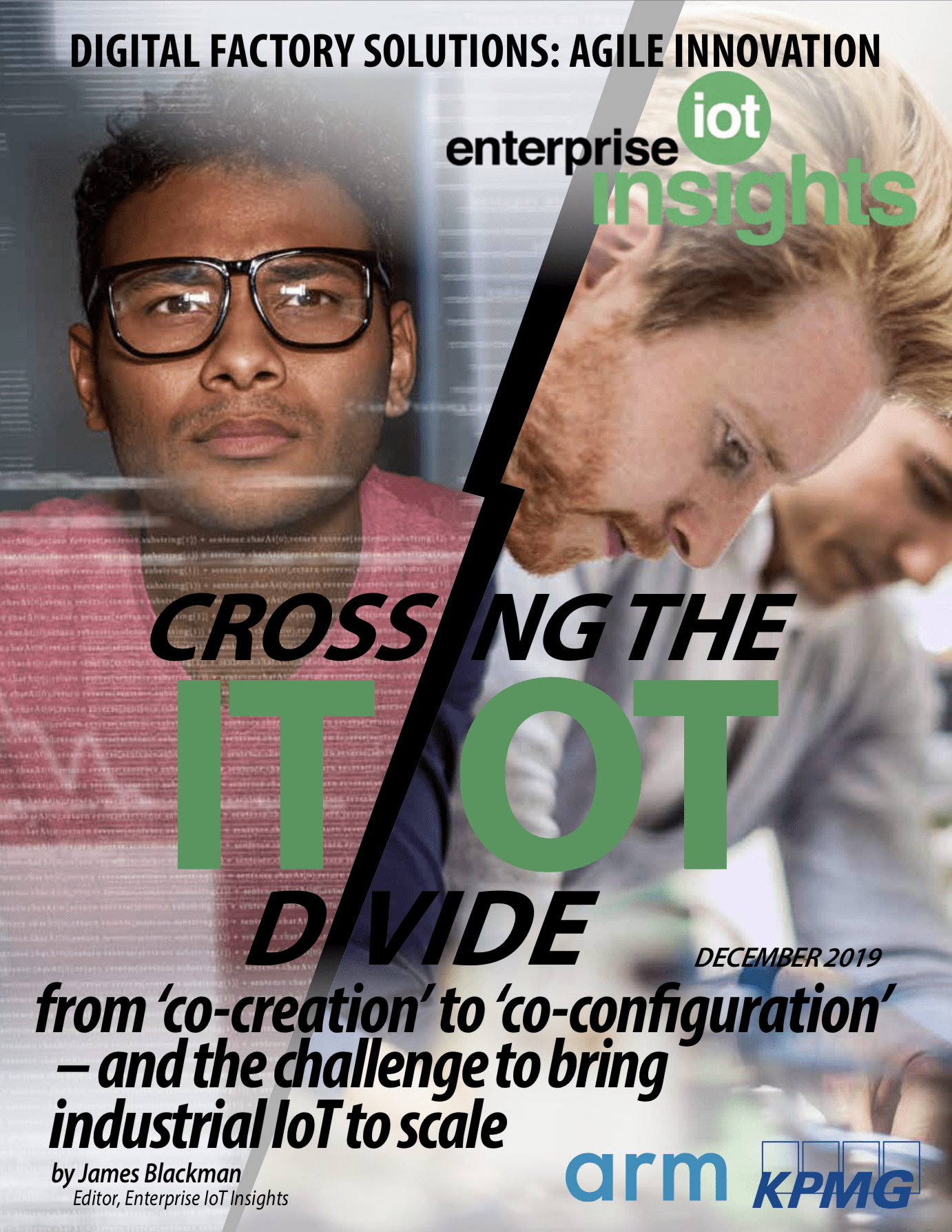Note, this is an excerpt from a new Enterprise IoT Insights editorial report, called ‘Crossing the IT/OT divide – co-creation, co-configuration, and how to bring industrial IoT to scale’. Go here for the full report (free to download).
The industry must go from proving technology to proving value. That is the line, as 2019 turns into 2020. It has to keep its eyes on the road, to stay on track. The technology works, and, even if the map is not written, there is little point gazing at the horizon when there is work to do.
The value must be revealed, now, in the negotiation between IT and OT. “Most industries have shifted their thinking to measuring and demonstrating value, some quicker than others,” comments Greg Corlis, managing director for emerging technologies at KPMG.
“Co-creation is not required to define value but it may be one of the components. Organizations need to evaluate the business problems they are trying to solve and determine how best to unlock the necessary value for the organization,” he says.
Corlis reverts to the idea of the technology platform as the start-point to scope out business problems, and to match solutions accordingly.

“Corporations should… seek foundational platforms to meet their business objectives. Once those platforms are in place enabling the next IoT use case should be close to a plug and play type solution with some customization but not to the scale required by implementing point solutions.”
Vodafone agrees: the technology works, and the challenge to make the business case requires less work than before – to the point, even, that ‘co-creation’ is tired as a concept, and a blocker for scale.
The IoT market is no longer so novel or messy that technology experts and domain experts – technology sellers and buyers, IT departments and OT functions – must work through protracted collaborations to create solutions from scratch, it suggests. There are, it turns out, only three use cases, or rather ‘use classes’, said Vodafone, and one of those doesn’t even exist yet.
Asset tracking and remote monitoring are the only ones that matter now; everything else riffs on these. “Forget all the 100s of use cases you see; forget all you know: there are only actually two use classes for IoT,” says Phil Skipper, head of IoT business development at the UK carrier, speaking at IoT Solutions World Congress in Barcelona in October.
The emergence of URLLC-grade 5G in release 16 and 17 of the 3GPP’s new rado (NR) standard, pegged for mid-2020 and late-2021, will introduce a third: a means for ultra-reliable industrial control for automated processes, machines, and vehicles.
But for now, before 5G gets real for industry, the market can spin-up a matrix of services off these other two use classes, which can be shown to deliver value already, and offer enterprises – including, most importantly, small and mid-sized firms, which have not, cannot, and will not invest in digital expertise required to foster their own solutions – magic tonics for digital change, available on subscription.
The IoT market is past co-creation, says Skipper, to arrive at a stage of ‘co-configuration’, where only the final 20 per cent needs to be configured in collaboration with enterprises, in order to make bespoke solutions for business-specific challenges. The rest – the lion’s share, the initial 80 per cent – of IoT solution-making is available in take-away form, as-a-service, with little required beyond shuffling the dials on connectivity, compute, and analytics.
That, then, is the message, actually, going into 2020: the market is making progress towards scaling IoT for industrial businesses of every stripe. It is the basis of Vodafone’s new Invent initiative, which seeks to enable enterprises to make their own IoT solutions, based on a take-away menu of IoT capabilities: 80 per cent off-the-shelf sausage making, plus 20 per cent in the seasoning of your choice.
“We are moving away from this idea of ‘co-creation’ towards this world where you have co-configuration, so you are adding the 20 per cent you need to make it a connected rat trap, or a connected chiller, or a connected HVAC system, rather than starting from scratch and having to build everything up,” says Skipper.
Hitachi Vantara, coming from the other side of the IT/OT divide, is drawing the same conclusion. It has packaged up its solutions as vertical-industry and horizontal-technology starter packs. It has two in the bag: one suite is called ‘manufacturing insights’, and cuts the solution mix various ways for digital factory setups; another is called ‘video insights’, which pre-packs LiDAR data models alongside sundry machine vision components.
The inclusion of three-dimensional LiDAR analytics in the latter suite gives industrial customers volumetric readings, as well, says Bjorn Andersson, the company’s senior director of IoT solution marketing – useful for measuring everything from incoming material flow on production lines, to carry-on luggage in airportq queues, to occupancy in public restrooms (without using camera).
Andersson comments: “The idea is to accelerate co-creation with customers, but also to package solutions for them. It used tobe that IoT solutions were always bespoke; just because they hadn’t been done before, in many cases. That’s changing; we want to get to that 80/20 rule, where we have standard components for 80 per cent of the functionality at least, and then we add a little on top to customize for the customer. Because there’s always something unique.”
But if the 80 per cent is ordered and simplified in IT, it is also automated and commodotised – and the value is taken out. The 20 per cent, by contrast, is where the work is done and the money is made – and where domain expertise is critical, and industrial change happens. Ryan Martin, analyst at ABI, brings the discussion back to its roots, about co-creation between IT and OT functions.
“The question is, who owns the 20 per cent,” he says.
“Where is the burden? Is it an IT thing, as with platform integration, or is it an OT thing, around training of analytics models? And increasingly, we see that 20 per cent favours OT, because OT has the on-the-job expertise to make stuff relevant, aside from integration. Once things are integrated, it’s just a maintenance-and-management issue – and those functions are being automated.”
Check out the new Enterprise IoT Insights editorial report, called ‘Crossing the IT/OT divide – co-creation, co-configuration, and how to bring industrial IoT to scale’.

